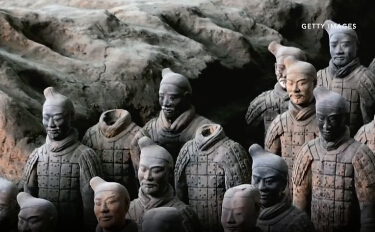It turns out China's famous terra-cotta army might have been influenced by the ancient Greeks.
中國(guó)著名的兵馬俑可能受古希臘人的影響。
Experts studying the sculpted warriors point to two important pieces of evidence.
專家根據(jù)兩項(xiàng)重要證據(jù)研究兵馬俑。
First, the Chinese didn't have a tradition of creating life-sized statues before the terra-cotta warriors — only small figurines. But the Greeks definitely did.
首先,兵馬俑前中國(guó)沒有制作真人大小雕像的傳統(tǒng),只有小雕像。但希臘人肯定有。
And one study found European DNA in northwest China. That suggests Westerners may have lived in the area around the time the army was created.
一項(xiàng)研究在中國(guó)西北部發(fā)現(xiàn)歐洲D(zhuǎn)NA。表明軍隊(duì)創(chuàng)建時(shí)期,西方人可能已經(jīng)生活在這個(gè)地區(qū)。

One of the archaeologists at the site told the BBC, We now have evidence that close contact existed ... before the formal opening of the Silk Road.
一位考古學(xué)家告訴英國(guó)廣播公司,我們現(xiàn)在有證據(jù)表明,在絲綢之路正式開始前中歐就有密切聯(lián)系。
And a historian studying the warriors said there might have even been Greek artists at the site to train locals.
一位兵馬俑研究歷史學(xué)家表示,甚至可能有希臘藝術(shù)家在現(xiàn)場(chǎng)培訓(xùn)當(dāng)?shù)厝恕?/p>
譯文屬可可原創(chuàng),僅供學(xué)習(xí)交流使用,未經(jīng)許可請(qǐng)勿轉(zhuǎn)載。











